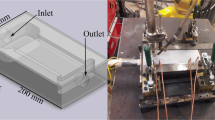Abstract
Within this manuscript, the comprehensive heat flow, as well as the energy balance for gas-shielded arc welding processes based on experimental investigations is discussed. The main focus lies on the gas metal arc welding (GMAW) process which is further analysed. Different calorimetric measurement methods and results for the separate determination of the energy content of droplet and welding arc as well as energy input into the component are presented. Additionally, heat losses to the surrounding atmosphere and the cooling energy of the external cooling power source system are analysed. The mean droplet temperatures are within a range of T dr = 2,350 … 2,700 °C. The studies also show that a specific manipulation of the droplet temperature during the welding process is not possible and droplet temperature depends on several parameters. Increasing the wire feed speed, reducing the diameter of the filler material or increasing the stick out length result in an increase of the droplet temperature. The analyses allow to conclude that the welding arc is mainly responsible for the weld seam penetration and the droplet temperature only contributes in a minor manner. Preliminary experiments also show that the heat input into the component is highly influenced by the selection of welding parameters. Measurements confirm that it is possible to increase the efficiency of welding processes for example by reducing the wire feed speed, using carbon dioxide shielding gas or increasing the stick out length. On the contrary, increasing the current or voltage or reducing the shielding gas flow reduces the process efficiency. The difference between the lowest and highest achievable value of efficiency can be more than 15 % for one specific welding process.
















Similar content being viewed by others
References
DIN EN 1011–1 (2009) Welding—recommendations for welding of metallic materials—Part 1: “General guidance for arc welding”; German version EN 1011–1
SEW 088 (1993) Supplemental sheet 2: “Weldable fine grained steels; guidelines for processing, particular for fusion welding”
Hälsig, Kusch, Mayr (2012) New findings on the efficiency of gas shielded arc welding. Weld World 56(11–12), ISSN: 0043–2288
Hälsig, Mayr (2013) Energy balance study of gas-shielded arc welding processes. Weld World, issue June 2013, doi:10.1007/s40194-013-0073-z, ISSN 0043–2288
Jenkins, Mendez, Eagar (2006) Effect of arc welding electrode temperature on vapor and fume composition. Weld J, ISSN 0043–2296, pp. 491–496
Rouffet, Wendt, Gött, Kozakov, Schöpp, Weltmann (2010) Spectroscopic investigation of the high-current phase of a pulsed GMAW process. Br J Appl Phys, issue 43, ISSN: 0022–3727, pp. 1–9, article No.: 434003
Schellhase (1985) Der Schweißlichtbogen – ein technologisches Werkzeug, VEB Verlag Technik, 1. issue, Berlin (only in German)
Jun, Hongming (2013) Effect of the wire temperature on the weld formation in GMAW. Adv Mater Res 652–654, S. 2289–2292
Acknowledgments
This work was part of research project IGF Nr. 15.562B/ DVS-Nr. 03.0378 of the research coalition “Deutscher Verband für Schweißen und verwandte Verfahren e.V.” (DVS) and was promoted by the programme for industrial alliance research (IGF). The financial support by “German Federal Ministry of Research and Technology” via the consortium “AiF” is gratefully acknowledged.
The Cluster of Excellence “Energy-Efficient Product and Process Innovation in Production Engineering” (eniPROD®) is funded by the European Union (European Regional Development Fund) and the Free State of Saxony. Further studies could be conducted only by promoting by the Excellence Initiative of the Chemnitz University of Technology “eniPROD”. For this promotion and support is gratefully acknowledged.

Author information
Authors and Affiliations
Corresponding author
Additional information
Doc. IIW-2505, recommended for publication by Commission XII “Arc Welding Processes and Production Systems.”
Rights and permissions
About this article
Cite this article
Haelsig, A., Kusch, M. & Mayr, P. Calorimetric analyses of the comprehensive heat flow for gas metal arc welding. Weld World 59, 191–199 (2015). https://doi.org/10.1007/s40194-014-0193-0
Received:
Accepted:
Published:
Issue Date:
DOI: https://doi.org/10.1007/s40194-014-0193-0




